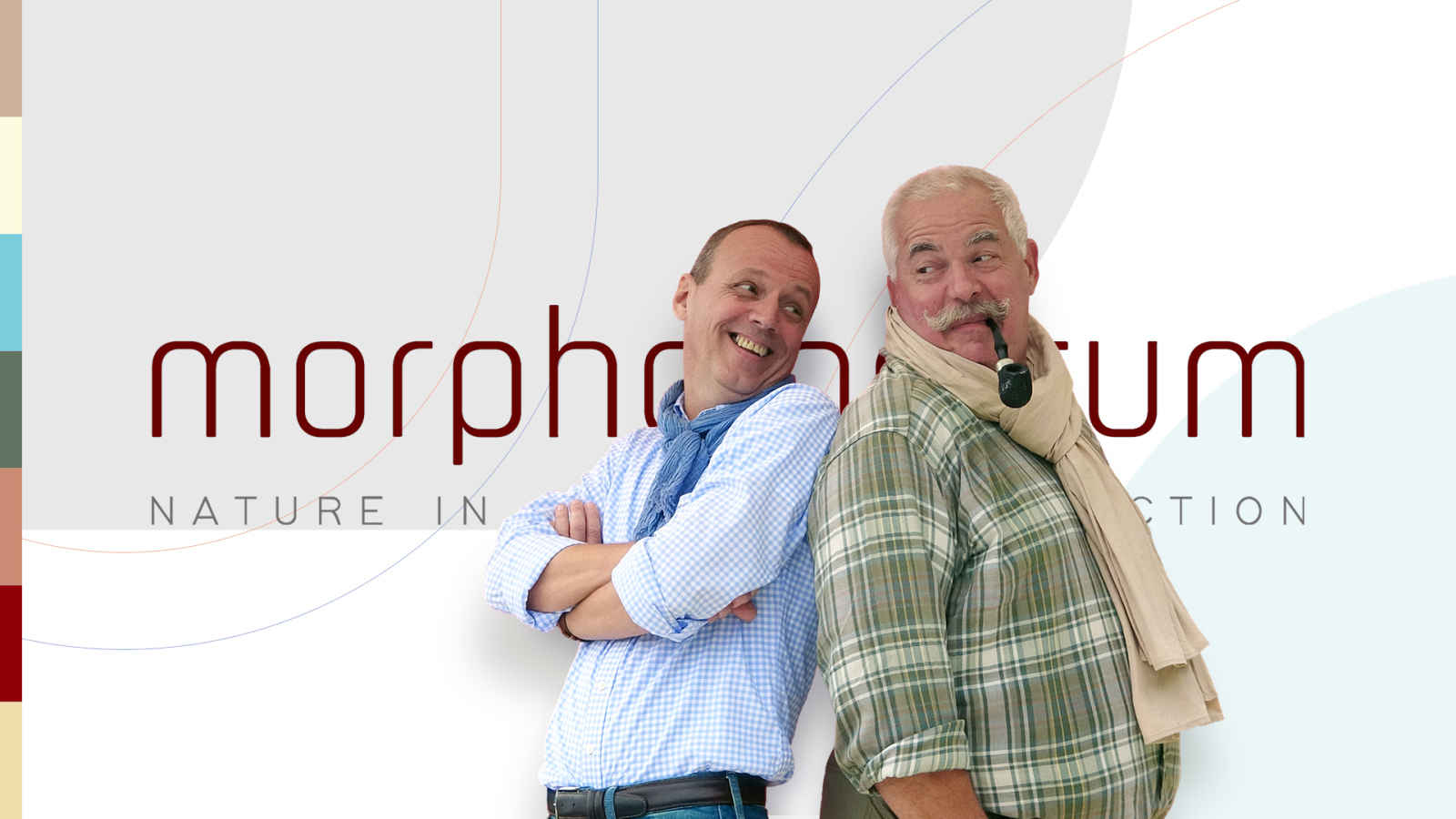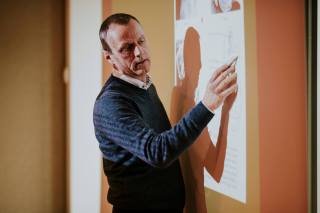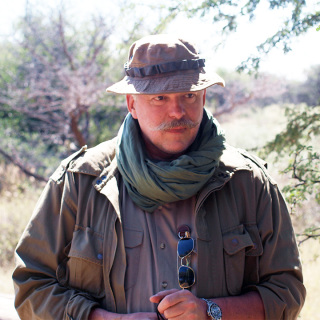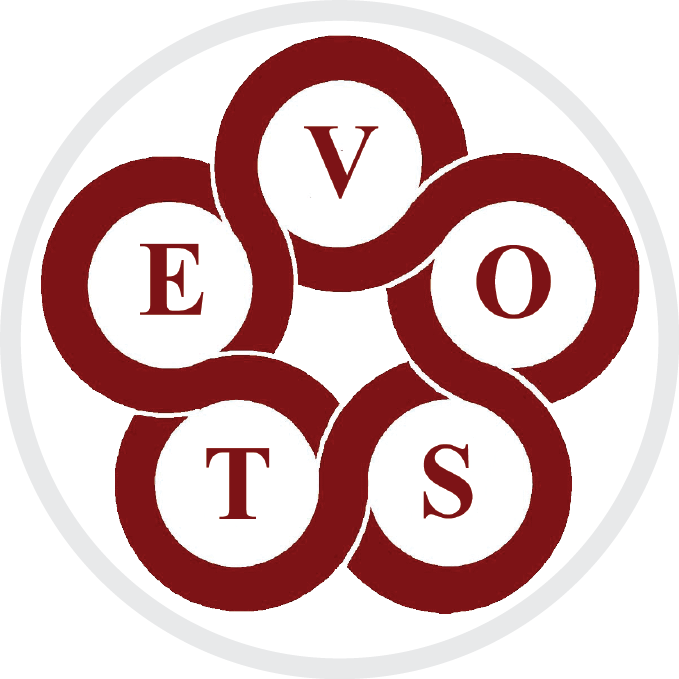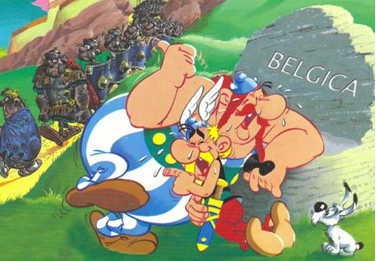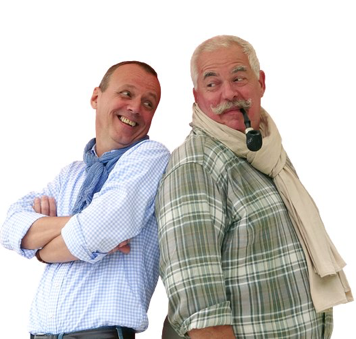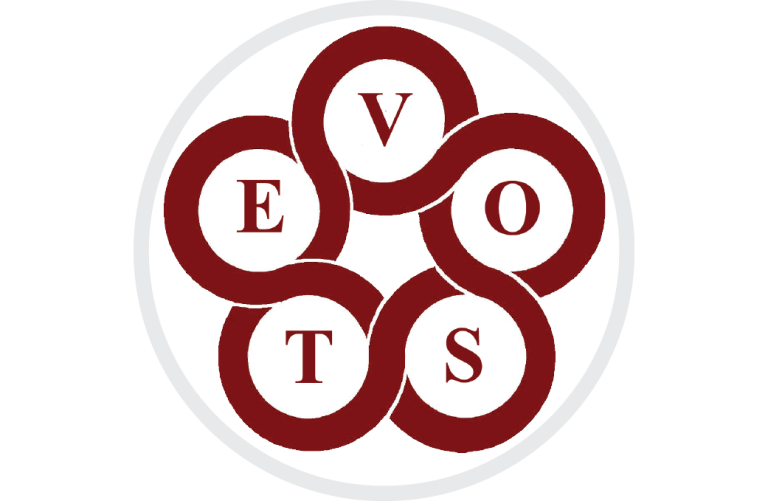Several people, professionals as well as students, asked us how did you come up with the whole EVOST concept in osteopathy? Well our answer is: 1 plus 1 makes 3. In many ways, EVOST emerges from the combination of a number of ingredients and circumstances.
- Max Girardin & Jean-Paul Höppner
Once upon a time…
To understand the contextual background for EVOST we need to tell you the story of two individuals. In fact, it should be said: two completely different individuals who – without knowing – would meet one day and – without intention – this encounter and interactions would lead to EVOST. Or with other words: EVOST is about two completely different individuals who share a common passion.
Assembling the tinder and positioning it
One individual: The Belgian guy talking (Max Girardin).
Sure, on my passport stands “Belgian” but for me it feels more that I have my roots in the African bush. Place where I lived for years. After returning back to Belgium I kept this interest for Nature while spending parts of my spare time in the Ardennes. You could say, while observing and learning, nature has put a stamp on my form. This happened in many ways more than the time that I spend in schools. Be it in secondary school or later inPhysiotherapy and Manual Therapy.
Finally I started to study osteopathy. In the early eighties, you had to be crazy if you wanted to study osteopathy in Belgium. Why would anyone change his/her officially recognized diploma for a study of 6 years that lead to a piece of paper saying that you are now an osteopath? A piece of paper that meant nothing at all, neither to patients nor to insurance companies – more over, being an osteopath could be interpreted as being illegal in those days!
The teachers at the Instititute William Garner Sutherland (IWGS) were dedicated and gave the best of them. But in being a loner or “steppewolf”, I trusted the original source more than what they told us in bits and pieces. Thus I bought the books of A.T. Still and started to study them intensively, over and over again… still do. In doing so, it made me slowly realize that our fantastic and motivated teachers were force-feeding us with a mixture of Still, Sutherland and John Martin Littlejohn stuff. For me there was no real logic behind it. It looked more a mixture of bits and pieces; probably a consequence of what they heard from their teachers. I came to the conclusion that for me, many of Still’s principles were either not mentioned or in the best, they were covered by tainted interpretations.
The principles … that what is hidden behind the curtain, the essence of Osteopathy, present everywhere but not in plain sight; that became my hunting ground. In a constant search for them I met a companion. My friend and brother in arms Jean-Paul is a “steppewolf” in his mind as well and in sharing common interests and common behaviors, circumstances brought us tighter together. Moreover, trying to understand these principles, it also made us rational sparring partners, which has laid a basis that still holds for more than 35 years.
In parallel to my osteopathic studies, I spend two days a week in the Pasteur Institute of Brussels to deepen my knowledge on the cell and tissue level with light and electronic microscopy for two years. I also spend two evenings a week at the university of Brussels (VUB) in the dissection room, studying human anatomy and micro anatomy and never stopped since 1985 because it is still an important source of information when it comes to the human form.
Besides the fact that my heart lies with anatomy in different dimensions, I also have a broad interest in physiology (To me it is dynamic anatomy in several dimensions). And especially the latter would open a door.
The Osteopathic school had a setback with the physiology teachings. I knew a M.D. from our anatomical department who was not against osteopathy (an exception to the rule those days!) and I made the suggestion that he might be able to establish the link between physiology and anatomy.
However, it turned out that he was not able to do so. Most likely because of the way how it was taught to himself. So, in this disconnected way not compatible with Still’s philosophy.
In that period, when I assisted his physiology classes, I gradually realized that there where three missing links in those teachings…
- The dimensional jumps taken without awareness,
- He was talking complex physiology (basic in his head) but the students had a very poor base in biochemistry, cytology and histology and could not connect what he was talking about with their reality and the patients they were dealing with…mainly biomechanics anatomical stuff.
- And last but not least there were dead images, he simply was not able to make them alive …make it a dynamic and living processes.
Afterwards, if I remember right, about two years he said to the director: “let Max give the Physiology, they understand him better than me.” And so, finally, I did.
For the first time I really had to structure my chaotic ‘go with the flow and deviating sometimes chaotic way of thinking’. It became an exercise that I had to train, again and again, for the osteopaths as well as for the university where I still taught as pro-sector, human dissection in the department of Morphology, and did my morphological and micro-anatomical research.
“Let Order come out of the Chaos”. And on that point the other ‘steppewolf’ was my constant ordering force …and he still is today. For sure there is a reason why students called us Asterix and Obelix - because of my slim waist of course… ;-)
One individual: The German guy talking (Jean-Paul Höppner).
Okay, on my passport is mentioned “German”. But it needs to be said that I was born and raised in Belgium. So I got the influence of both worlds: “richtig ist richtig” and learning how to bend with the wind (I am still a work in progress on that last one). On many pictures in the family album you can see me making drawings but also playing in the woods behind my parent’s house. We were making camps and tree houses and learned for instance that playing with matches and dry grass will have consequences –> it changes the look of nature dramatically! At that time, not fully aware, in a certain way I was busy with form: trying to blend in a camp with the bushes and trees but also trying to figure out how to define a form like the shape of a face as I tried to draw it.
This creative way of being was soon to be suppressed by my teachers at school. Latin, math and science took over. They drilled me into a (almost perfect) reasoning machine… But somehow I was still intrigued by nature and form and I have to thank my biology teacher for showing me a complete new world. A new world while we were doing the dissection of a rabbit. Yes, we did it ourselves at the age of 14 because she was convinced that it was her job to inspire us, by letting us do things by ourselves. And she was also convinced that we could only learn when we did things ourselves. And so, that fine day, I discovered by and for myself a new world: a world hidden underneath the skin.
In those days you would have found a lot of airplane models in my bedroom. Models I made myself. So I already had some notion of the fact that you need to put the plastic parts (structures) in a correct position in order to get a form that looks like an airplane and not some strange what-ever-it-might-be. Discovering these parts underneath the skin made me aware that the rabbit looks like this because it is made out of so many different parts. Getting this insight did not make my mother very happy since I started to dissect mice and other creatures… And I decided: the next step should be man!
It became obvious to me that if I wanted to understand the human form I needed to study medicine. It was the only way to be able to do dissection. It turned out that medicine was about test tubes and a lot of chemistry. And very little about anatomy. Consequently there was frustration and this led to the clash of characters and ended my medical studies. My parents always thought that the two years were wasted. I do not agree, it was a step to further insight: form in one dimension is the consequence of structures in other underlying dimensions.
But what to do now? How to continue in nourishing my hunger for anatomy?
The decision seemed to be easy: studying physiotherapy. And in doing so I met a guy who would become my best friend.
My best friend and my brother in arms against ignorance for the last 35 years (and most likely for the following years as well). Physiotherapy, well not our cup of tea! So when my friend Max told me about Osteopathy, it was clear to me: change of direction. My parents however asked me politely to finish first my studies before starting a 3rd one. In respect for them I did so.
As soon as I began my osteopathic studies there were some legal/political issues that forced Max and me to get a “masters degree”. We did not see the benefit of it but at least we could do dissection classes. And so we did. This was the starting point of becoming pro-sector at the university of Brussels. It was also the starting point of many discussions we had about Form, Structure, Function, Principles, etc..
It finally ended up that the both of us became a teacher at the Institute where we studied osteopathy and received our D.O.. It was a period in our lives where we spent a lot of time together: giving lectures, sharing hotel rooms, having a lot of dinner discussions, … We were and still are the complete opposite (look for instance at the comparison of Asterix & Obelix). But in those days we became more and more “the one who fills up the pieces of the puzzle of the other and vice versa”. Slowly but surely there was a common living picture emerging.
The Ignition – Part 1
It was in those days that the ignition happened: already during our studies we realized that the osteopathic principles were everywhere, in all these dimensions: macroscopically, microscopically and sub-microscopically. Dimensions of which our colleagues (as well as some teachers) seem to know little and thus could not see them: from the biochemistry over the cytology, through the histology and micro-anatomy towards the macro-anatomy. In most cases only the latter was their world…
We were both going through a process of gaining more and more insight. Each of us with our own personal interest: for Max it is Phylogenesis and for Jean-Paul it is Ontogenesis. Each of us wandering through the different dimensions of our interest field, but always connected by the same connecting point: principles.
When we both became teachers at the College Sutherland (former IWGS, the name changed over the years) we both wrote our own manuscripts. In doing so we tried to connect the “classic knowledge” by gluing them together with principles. This was a slow going process because trying to explain something so complex as a human form requires a profound insight and correct vocabulary!
The best way to practice this? Teach it!
The school became our playing ground as we tried to figure out how to explain it the easiest way, while still being (academically & philosophically) correct.
For many years the College Sutherland (Belgium, Netherlands, Germany) was our playground and the daily experience in the different countries were a challenging input to our brains as a tool for reasoning.
Certainly in the beginning we could not imagine the impact that was building up. But we did see the effect on some of our students. We could compare what we were doing at the school on one hand and with our teachings in a postgraduate context on the other. And we noticed that, more and more, we had to defend our way of thinking out of the boxes to some of our colleagues.
The Ignition – Part 2
In 1996 the director of the College Sutherland asked if Max could imagine a full time education in Germany based on the red line of Evolution. Max could convince him that it could be possible. But only with a “carte blanche”.
He got the “carte blanche” and together with his brother in arms Jean-Paul, they began to write a complete 5-year planning. Although the last part for the 5 years was not fully completed in detail, already in 1998 the first year started with a full-time education based on what both had put on paper.
Writing all these programs was not a smooth process. Although they both noticed that they work as a tandem, both changing position from time to time, the outcome was clear but the road to get there was not always shared by the other one. Many questions were to be solved: how to unite the academic world with Still’s philosophy; what principles should be used as educational guidance; what-who-when; … So on a regular basis they had many and sometimes even heated discussions, often till deep in the night.
Gradually the rhetorical background of Jean-Paul (thanks to his former Latin drill sergeant convinced Max that they would need a terminology. A new one. One that made discussions as they had unnecessary. Because they came to the conclusion that even when they had their discussions, when it seemed they were saying something different, they were talking about the same. But only with different words.
Examples:
- Embryology: three layers of origin (finally only two), to build all organs and organism with each their own intrinsic and extrinsic hierarchy and chronology and behaviors
- Histology: four tissues of origin to build organs and organism, with each their own intrinsic and extrinsic hierarchy and chronology and behaviors
- Cytology: about 220 differentiated cells, to build tissues and embryological original layers, with each their own intrinsic and extrinsic hierarchy and chronology and behaviors
- Anatomy: a zillion of structures, subdivide in musculoskeletal, visceral, nerves, circulatory system etc. to build an organism, with each their own intrinsic and extrinsic hierarchy and chronology and behaviors
Sometimes it felt as an impossible task and, as already stated, more than once it lead to high tempered sparring discussions luckily the shared trust, friendship and the passion for osteopathic principles and nature were stronger.
Nevertheless, it all seemed to good to be true. And it did not take so much time before this first cracks appeared. But not between the two of them! Already during the second year dark clouds showed up at the horizon. To the “carte blanche” there came some conditions imposed by the institute. Conditions that were ignoring fundamental principles but serving certain other mercantile means. Their friendship was put to the test. But to much they were connected and both were true to their principles. And “richtig ist richtig” Jean-Paul said.
Consequently they both left the school and Jean-Paul kept the papers regarding the program for the remaining 3 years to himself. Too much effort the both of them had put into this project that they did not want that it would be altered to benefit other purposes.
Intermezzo
After they both left the institute new dark clouds appeared on the horizon. But this time not professionally but more of a private kind. Due to the dead of a family member Jean-Paul left the stage for almost 2 years. A period where he did not teach at all. In the meanwhile Max was still active. Active by experimenting with the idea of turning the original thoughts behind the full-time education into a postgraduate program.
In the summer of 2002 he invited Jean-Paul and his wife for a dinner at his place. He explained what he had been doing and asked him: do you want to fill in the pieces of the puzzle as we are used to do? Or not? Say it now so I can go on, either way.
He agreed to re-connect and so the original idea had turned now into a new direction: keeping the principles of osteopathy alive by showing them to colleagues who already finished their education. Slowly but surely they both picked up where they left their original concept 2 years prior.
The process still going on
Although quite a lot of the material was put on paper, still a lot work had to be done. And as the tandem picked up speed, new insights were gained. As Craig Holdrege from the Nature Institute puts so well “The Giraffe’s Long Neck” : “Just think of when we have an “Aha!” experience, a new insight that sheds bright new light on things. Such new insights are of course usually borne out of strenuous efforts—perhaps longer periods of time in which nothing “comes”—and then at once a new insight is there. It does not simply grow gradually in incremental steps by adding on to past knowledge; it is a new idea that reorganizes our past knowledge, revealing new relationships and connections—and giving rise to new questions. Our body of knowledge takes on a new gestalt.”
The major breakthrough
A major breakthrough came when we realized that the wrong word or rather concept in all descriptions is the phrase “in order to build”… Blasting blind moles! Why did not we see this earlier?
In nature “in order to Build” does not exist, that is a human interpretation – construct (an analogy combined with a covering of anthropomorphism). The whole is rather, in reality, a zillion of local constantly changing interactions leading at some point to a global order, that materializes into a recognizable pattern: we see as - and call accordingly - structure with function… And depending of the science branch you are most embedded in, you use a specific set of eyeglasses to look at the subject and by habit use the terminology of that science…
But A.T. Still did not talk about that, he talked about FORM, the indivisible ‘whole reality of function-structure’, and the nature’s principles at work in it and all over.
At the moment when we simultaneously realized this, the epiphany is indescribable!
Around that period Max was also deeply looking into Darwinian or Evolutionary medicine, and thus came up with the thought of sharing our thoughts and findings with at least a part of the profession, and see what their reaction was on it? And to give the child a name came up with ‘Evolutionary Medicine within the Osteopathic Field’ or in short EVOST. The emblem was Jean Paul’s work and idea and as he said in the beginning: he knew how to draw since he was little ;-)
A second big part of lighting the tinder
It was clear to us that A.T.Still’s writings constantly revolve around a few ‘attractors’, which were often dismissed by the profession at the time and apparently still today; at least those parts of the profession that we were in contact with anyhow.
Schooling in Osteopathy on the European continent had gradually evolved and shifted more and more into a ‘technique based’ instruction, and by that type of education they are developing “little Sherlock’s of the dysfunction” with the according tests to find them and techniques to deal with them. (Actually in our eyes a bad copy of school medicine but then less disciplined, clearly)
For us the point of rupture was around the year 2000, it became physically and mentally impossible to remain in such a schooling system (see also above).
In 2000, at that time, our thoughts had already taken a different road and consequently, inevitable, the moment came where we both went “our way”. Our road led us to philosophy, morphology, history and return towards the evolutionary and developmental (nature) bases of osteopathy.
The A.T. Still attractors in our analysis were Health and not disease, Nature’s principlesand not human divided constructs-models and their according terminology, Evolution and development towards complexity as a natural process that clearly was the same natural principles expressing over and over again in changing dimensions and in certain time frames (space time). And and last but not least the system-environment as a whole andnot reaping things out of their context but trying to see them in their natural contextual environment.
This was still very difficult to put under consistent words (because we were still partly lingering in our habitual old scientific branches languages), until we got the language given to us by a participant of the first Evost class, Eddy Gysbrechts D.O., he said:
“ guy’s you are talking in principles about complexity and systems, and self organization…you should read Roger Lewin’s book: Complexity: Life at edge of chaos!”
That made the terminology much more streamlined and consistent, like a puzzle of words, all seemed to fall into place. Jean-Paul as ordering factor was crucial in that discipline…(he does like to play The Devil’s advocate)
Evolution - Nature and health, these were the two instigators that made us suspect that A.T. Still was talking about the natural mechanism of Life: evolution…
And then, Max will always remain grateful to Carol Trowbridge for receiving her book on A.T.Still. From chapter 4 on she demonstrates with references that most probably the ‘theory of evolution’ was indeed a big part of the coming into being of ‘the old doctor’s idea’: Osteopathy.
Examples of citations:
- Osteopathy is found in Nature, Osteopathy is founded on Nature, Osteopathy is Nature. (A. T. Still 1894)
- Osteopathy as representative of a process is the application of certain evolutionary forces. …on which we depend for our (practical) daily work…
- Evolution and osteopathy represent parallel lines, or rather one is part of the other. Osteopathy is applied evolution.
- We know both evolution and osteopathy to be facts, and they both deal with the welfare of the living body. (While molding it…)
- One thing is certain, it is inviolable law that both evolution and osteopathy represent…
( C.P. McConnell :Osteopathy in the light of evolution, Journal of Amer. Osteo. Associaton, vol 12, ° 9, May 1913) - He (Dr. A.T. Still) had worked those (principles) out along similar lines with Darwin, Wallace and Spencer at a time when the ideas of these researches were not common knowledge.
(Edythe F. Ashmore on the death of A.T. Still, “ The Western Osteopath, Vol.12, no. 7, Dec. 1917) (This citation was found and communicated to Max by Carol Trowbridge but is not in her book on A.T. Still)
The fire is taking with intermittence but slowly really gets going
About location and language – different attempts
The whole idea behind EVOST as a postgraduate program was slowly but surely something in becoming. We wanted to share that. Well knowing that the story is neither a truth chiseled in stone nor ever finished.
As Craig Holdrege beautifully puts it: “Placing the holistic gestalt of the organism back into the center of evolutionary considerations has enormous implications. We can no longer look at animal evolution as the out- come of the interaction of causal mechanisms. We are always led back to beings that evolve in relation to other beings and to the many inorganic forces of nature. Beings interact and coevolve; yet each evolves in its particular fashion. No being is reducible to something else. This is a central riddle of life on earth, of development, and in the end, of evolution.”
Consequently we invited some of our colleagues personally. We did that for different nationalities and without any advertising.
The first EVOST introduction course or test run was in Johannesburg in the year 2000, it ran until 2004 if I remember correctly. Unfortunately the course in South-Africa was ended abruptly when Robert Mugabe president of Zimbabwe, started the Farm grabbings and disrupted not only the political and economical climate of his country but also of South-Africa.
The first EVOST seminar on the European continent was in Belgium in 2003.
Ever since we have already seen 11 new groups and every 1-year and a half a new group is starting. Over the years the word was spread and more and more colleagues find their way to EVOST, either by mouth-to-mouth or by publishing new dates open for Osteopaths from all over the world.
All our lectures are in English because we get a diverse and international public, which creates an experience and dynamic of its own.
Nice anecdote: because we were discrete the first years, there were even idiots (some publishers and teachers)(for definition: see A.T. Still, Research & Practice, page 137) who proclaimed publicly that EVOST was a secret society…
Several osteopaths asked us to come to their country with the EVOST course or do EVOST in their language. We prefer not to do so for several reasons.
The most important reason is that we want to have an international group of attendants. Belgium in the heart of Europe (most colleagues come from here) is an ideal location. And about the language: exchanging ideas and opinions requires a common language among an international group of people. Some colleagues see this as a threshold but by experience they notice that it works fine. It is no problem to translate bits and pieces into their own language, either by us or by some colleagues if necessary.
And you should not forget, Evost, we also do the course in English because we use Still’s originals we do this constantly and push our attendants to read them in the original versions (with Drew’s dictionary at hand: Webster 1828), not the translations…as goes the Italian saying:
“Traduttore traditore” – Translating is betraying.
Over the years we see the dynamics that bloom when people from different nationalities and osteopathic schoolings are together. All-together in trying to go into a new paradigm with their language is quite something… It would not be the same in another country and with all students of that country and in French or German for instance…. Probably impossible.
Two sides of the same story
Another unique feature of the EVOST course is that the participants first get Max and his way of looking at phylogeny. After 3 seminars Jean-Paul explains the same story form an ontogenetic point of view. And here as well, the development of the human is told in a completely different way as it is mostly the case.
After walking through these two (apparently) different landscapes the seminar “synthesis” follows.
During this seminar the participants become confronted with a number of questions, which they have to solve.
Interesting detail: the participants will discuss the answer and outcome of the question; Max and Jean-Paul are merely moderators. On occasions it happens that colleagues of former groups join the discussion weekend.
Every synthesis weekend is different and demonstrates in many ways what a complex adaptive system can mean. That seminar is almost a complex adaptive system in itself…. very impressive when it gets going…
Another jump in level of complexity.
In a final chapter Max and Jane Stark are demonstrating the principles in levels of complexity such as for instance cultural. Jane Stark from Canada joined in because of her extended knowledge on the writing of A.T. Still. Both discuss many topics related to the person behind Osteopathy. The seminars puts words in a context that allows to re-define what Still meant with words such as matter, motion, mind, spirit, … For more than one colleague a sobering experience.
EVOST and Morphologicum
Up until some years ago Max and Jean-Paul were present on different platforms. Each platform had his own website. In 2015 they decided to create one platform, or should we say one umbrella, where all their activities are present. The idea came – as both recall well – from Jean-Paul because he noticed that quite some colleagues got lost in their quest for solid background information. By bringing all these platforms, these courses, these seminars under one title it enables each colleague to find a suited subject for him/her. So, EVOST is only one of the many postgraduate courses offered by Max and Jean-Paul. And there is more. Morphologicum also want to be a platform for those who share the same interest.
We both hope that this text answers some of your questions. If not, please feel free to join us and become one of many fellows we already are.

